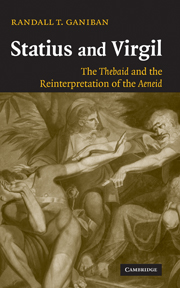Book contents
- Frontmatter
- Contents
- Preface
- List of abbreviations
- 1 Introduction
- 2 Oedipus' curse
- 3 Horror, prophecy, and the gods
- 4 Hypsipyle's narrative of nefas
- 5 Bacchus and the outbreak of war
- 6 Dis and the domination of hell
- 7 Delay and the rout of Pietas
- 8 Spectacle, crime, and monarchy at Thebes
- 9 Pietas, burial, and clementia in a world of nefas
- Works cited
- General index
- Index locorum
4 - Hypsipyle's narrative of nefas
Published online by Cambridge University Press: 22 September 2009
- Frontmatter
- Contents
- Preface
- List of abbreviations
- 1 Introduction
- 2 Oedipus' curse
- 3 Horror, prophecy, and the gods
- 4 Hypsipyle's narrative of nefas
- 5 Bacchus and the outbreak of war
- 6 Dis and the domination of hell
- 7 Delay and the rout of Pietas
- 8 Spectacle, crime, and monarchy at Thebes
- 9 Pietas, burial, and clementia in a world of nefas
- Works cited
- General index
- Index locorum
Summary
As the Argives march through Nemea on their way to Thebes, they are beset by a terrible drought. A woman they encounter leads the army to the river Langia, where the men slake their nearly fatal thirsts. When asked about her identity, Hypsipyle, former queen now turned slave, groans, as she remembers and relives the horror of her past: redit ecce nefas et frigida cordi/ Eumenis (“Look, the nefas returns and the Fury that chills my heart,” 5.32–3). Though seemingly reluctant, Hypsipyle proceeds to tell her tale: the Lemnian women's massacre of their men, their dalliance with the Argonauts, and her own subsequent exile and servitude in Nemea. Hypsipyle's tale is one of nefas. To tell it, she wrests the narrative from the poet Statius for nearly 450 lines. Her narrative is embedded in Statius'; one tale of nefas replaces another being committed. The Hypsipyle episode consequently has a special relationship to the epic as a whole.
Like Coroebus, Hypsipyle is a figure of pietas. But Hypsipyle plays a role that sets her apart. More than any other character in the epic, she is specifically and self-consciously modeled on Virgil's Aeneas. Indeed she represents the most direct use of Aeneas in the Thebaid. Yet despite this important Virgilian model, her pietas is even more personally destructive than it had been for Coroebus.
In this chapter I will examine Hypsipyle's tale and argue that it displays the inability of Aeneas-figures to exist in the Thebaid.
- Type
- Chapter
- Information
- Statius and VirgilThe Thebaid and the Reinterpretation of the Aeneid, pp. 71 - 95Publisher: Cambridge University PressPrint publication year: 2007



